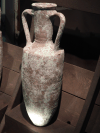
Pylos, its harbor, and the bay of Navarino. (657k)
From the Pylos entry in Wikipedia:
Pylos, historically also known as Navarino, is a town and a former municipality in Messenia, Peloponnese, Greece. It is the main harbor on the Bay of Navarino.
Pylos has been inhabited since Neolithic times. It was a significant kingdom in Mycenaean Greece, with remains of the so-called "Palace of Nestor" excavated nearby, named after Nestor, the king of Pylos in Homer's Iliad. In Classical times, the site was uninhabited, but became the site of the Battle of Pylos in 425 BCE, during the Peloponnesian War. After that, Pylos is scarcely mentioned until the 13th century, when it became part of the Frankish Principality of Achaea. Increasingly known by its French name of Port-de-Jonc or its Italian name Navarino, in the 1280s the Franks built the Old Navarino castle on the site. Pylos came under the control of the Republic of Venice from 1417 until 1500, when it was conquered by the Ottoman Empire. The Ottomans used Pylos and its bay as a naval base, and built the New Navarino fortress there. The area remained under Ottoman control, with the exception of a brief period of renewed Venetian rule in 1685–1715 and a Russian occupation in 1770–71, until the outbreak of the Greek War of Independence in 1821. Ibrahim Pasha of Egypt recovered it for the Ottomans in 1825, but the defeat of the Turco-Egyptian fleet in the 1827 Battle of Navarino and the French military intervention of the 1828 Morea expedition forced Ibrahim to withdraw from the Peloponnese and confirmed Greek independence. The current city was built outside the fortress walls by the military engineers of the Morea expedition from 1829 and the name Pylos was revived by royal decree in 1833.
All pictures are © Dr. Günther Eichhorn, unless otherwise noted.
The fortress of New Navarino is an Ottoman fortification near Pylos, Greece. It is one of two castles guarding the strategic Bay of Pylos, on which it sits; New Navarino is located in the southern entrance of the bay, while the northern entrance is guarded by the 13th-century Old Navarino castle, built by the Crusaders of the Principality of Achaea. In juxtaposition with the latter, New Navarino is often known simply as Neokastro or Niokastro
The fortress was built by the Kapudan Pasha Uluç Ali Reis in 1572/3, shortly after the Battle of Lepanto. In 1645, Navarino was used as a base for the invasion of Crete during the opening stages of the Cretan War. During the Morean War, the Republic of Venice under Francesco Morosini captured both fortresses at Navarino in 1686, defended by Mustafa Pasha and Djafer Pasha respectively. Along with the rest of the Peloponnese, the fortresses remained in Venetian hands until 1715, when the Ottomans recaptured the entire peninsula.
The fortress was captured by the Russians on 10 April 1770, during the Russo-Turkish War of 1768–74 and the Russian-inspired Orlov Revolt in Greece, after a six-day siege, and the Ottoman garrison was allowed to evacuate to Crete. Russian control was brief: already on 1 June 1770, the Russian fleet abandoned Navarino, which they destroyed in part, to the Ottomans.
After the outbreak of the Greek War of Independence in March 1821, the Greeks besieged the fortress for several months. The garrison surrendered in the first week of August 1821 after being assured of safe passage, but were all massacred. The fortress remained in Greek hands until captured by Ibrahim Pasha of Egypt on 11 May 1825. The Ottoman-Egyptian garrison remained in the fortress until it was handed over to the French troops of the Morea expedition under General Nicolas Joseph Maison in October 1828.
In 1830, the modern town of Pylos was founded outside the fortress walls. The fort was abandoned and its citadel used for a long time as a prison facility.
























This page contains 24 pictures
Here are the links to the other main pages on Greece:
Page last updated on Fri Jul 8 19:10:45 2022 (Mountain Standard Time)
Pylos on acro.guenther-eichhorn.com